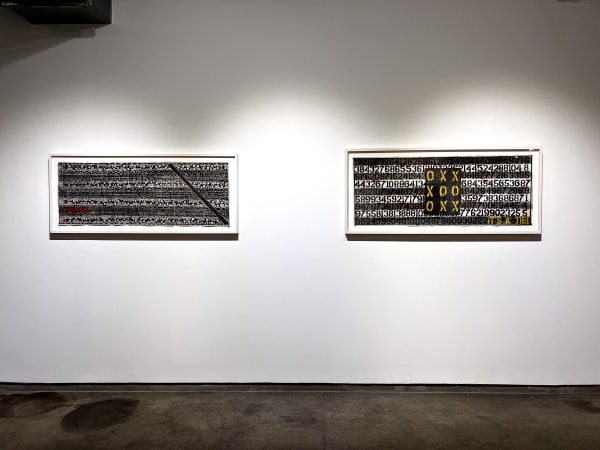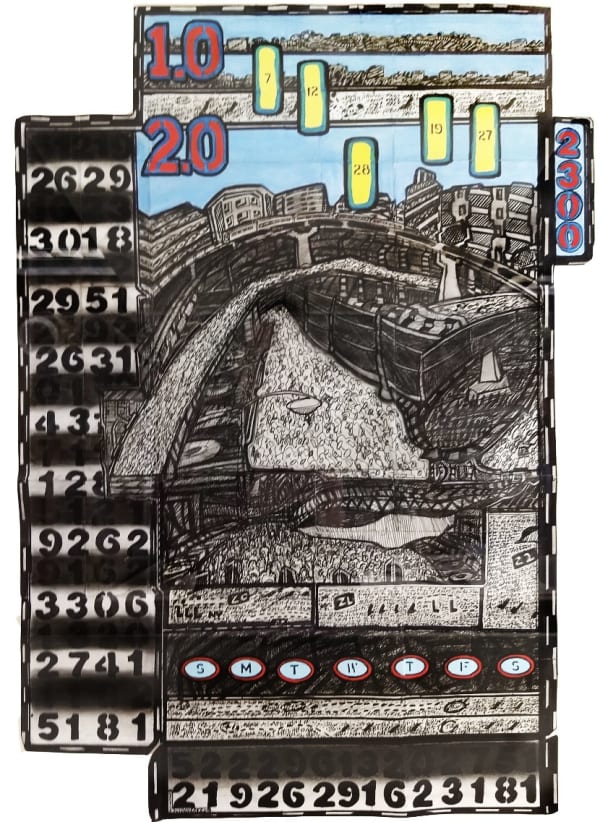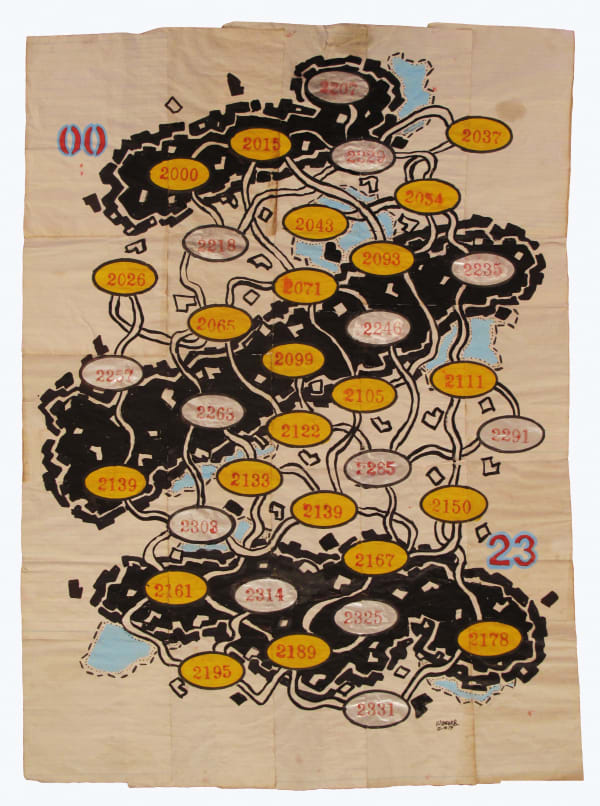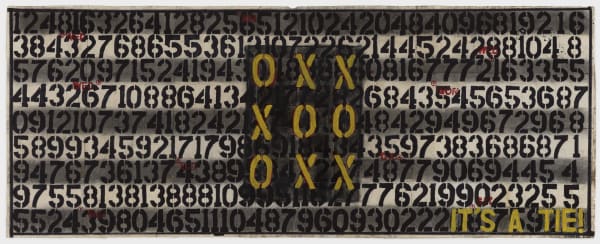George Widener: Count Down
“Functional MRI have shown that my brain is wired slightly differently; it seems to have unusual activity that results in some innate math, memory, and drawing skills. I’ve calculated dates and specific number systems since I was a child. I’d see common numbers around me (a license plate, a house number) and immediately transform them into dates,” remembers George Widener about his early experience as an odd and gifted child.
Widener was born in Cincinnati, Ohio, in 1962 and although he had an outstanding ability with numbers, his childhood was marked by awkward social behavior. At eighteen he left rural Kentucky to join the US Air Force. He experienced a terrorist bombing and several other traumatic events while he was in Cold War era NATO West Germany. After being discharged, his plan was to become a mechanical engineer, but he was led astray by a growing obsession with dates, numbers, disasters, and the practice of automatic memory drawing. He created a personalized counting system that he kept in notebooks, hidden in his backpack. For some years, he worked odd jobs and slept in shelters, secretly filling the notebooks, often in libraries. He returned overseas to live, working as construction laborer, bricklayer, and scrap metal collector—often having to stay in parks or abandoned buildings (squats). He focused relentlessly on his notebooks and began his elaborating upon the Megalopolis idea.
In the late 1990s Widener was diagnosed with Asperger’s syndrome (which was surely linked to the subconscious lighting calculating skills that made him a calendar savant from an early age) and enrolled in a Tennessee State vocational rehabilitation program, where he was discovered and introduced to the art world.
Widener uses found and pieced paper to create mixed-media works with bold color palettes and intricate patterning. His innate ability in drawing materializes in conjunction with his preoccupation with the space/time continuum, possible numerical systems, and mind games based on historical events and dates. The sinking of the Titanic has been a fixation since he discovered that a George D. Widener from Philadelphia and his son died on the ship. “The subject of my work is that of time and, more precisely, the shifting and symmetry of time—which I believe occupy every individual’s subconscious,” says the artist, adding: “I believe that truths are often revealed in unexpected divergent events, the past and the future are joined in subtle ways. I’ve been interested in disasters as an anthropology project of sorts.”
Throughout his career, now spanning almost three decades, Widener has created distinct bodies of work that represent the depth and versatility of his visual and conceptual toolbox. Count Down presents a survey of work from diverse series: Megalopolis, Robot Teaching Games, Crispr, Maps, Magic Circles, Calendrical Computations, Cityscapes/Mindscapes, and Gambling/Probability—created between 2010 and 2022.
Today, Widener is highly visible in the contemporary art arena and has had significant film and media exposure: he was a subject in the documentary film My Brilliant Brain: Accidental Genius (2007) and was profiled in the last episode of Ingenious Minds, a six-part series of films focusing on savants and geniuses, which aired on the Discovery Science Channel (2011). His work has been exhibited extensively worldwide, including Hiding Places: Memory in the Arts (John Michael Kohler Arts Center, 2011), The Alternative Guide to the Universe (Hayward Gallery, London 2012), and Secret Universe (Hamburger Bahnhof, Berlin 2013). Count Down is the artist’s fourth one-person exhibition at Ricco/Maresca Gallery.
Widener’s work is in private and museum collections worldwide, including the American Folk Art Museum in New York, the National Gallery of Art in Washington D.C., the Philadelphia Museum of Art, Intuit: The Center for Intuitive and Outsider Art in Chicago, the Hamburger Bahnhof Museum in Berlin, the Museum Gugging in Klosterneuburg, Austria, the Kroller-Muller Museum in the Netherlands, the Collection de l’Art Brut in Lausanne, Switzerland, the abcd/ ART BRUT collection and the Centre Pompidou, both in Paris.
-
 George WidenerMegalopolis 283, 2010Mixed media on paperSight: 19 x 50 in. (48.3 x 127 cm.)
George WidenerMegalopolis 283, 2010Mixed media on paperSight: 19 x 50 in. (48.3 x 127 cm.)
Framed: 35 x 55 3/4 in. (88.9 x 141.6 cm.)(GW 13)SOLD -
 George Widener
George WidenerMagic Circles, 2017
Mixed media on paperSight: 45 1/2 x 46 3/4 in. (115.6 x 118.7 cm.)
Framed: 51 x 52 3/4 in. (129.5 x 134 cm.)(GW 175) -
 George WidenerUntitled, 2016Mixed media on paperSight: 25 3/4 x 49 1/4 in. (65.4 x 125.1 cm.)
George WidenerUntitled, 2016Mixed media on paperSight: 25 3/4 x 49 1/4 in. (65.4 x 125.1 cm.)
Framed: 31 x 54 1/2 in. (78.7 x 138.4 cm.)(GW 151) -
 George WidenerTime Map (Robot Puzzle Series), 2013Mixed media on paperSight: 59 1/4 x 56 3/4 in (150.5 x 144.1 cm)
George WidenerTime Map (Robot Puzzle Series), 2013Mixed media on paperSight: 59 1/4 x 56 3/4 in (150.5 x 144.1 cm)
Framed: 65 x 62 in (165.1 x 157.5 cm)(GW 67)
-
 George WidenerMagic Circles, 2018Mixed mediaSight: 21 x 21 in. (53.3 x 53.3 cm.)
George WidenerMagic Circles, 2018Mixed mediaSight: 21 x 21 in. (53.3 x 53.3 cm.)
Framed: 25 x 25 in. (63.5 x 63.5 cm.)(GW 180) -
 George WidenerInner Landscape No. 1, 2018Mixed media on paperSight: 31 x 22 1/4 in. (78.7 x 56.5 cm.)
George WidenerInner Landscape No. 1, 2018Mixed media on paperSight: 31 x 22 1/4 in. (78.7 x 56.5 cm.)
Framed: 36 x 26 3/4 in. (91.4 x 67.9 cm.)(GW 195) -
 George WidenerFIB DAYS, 2018Mixed media on paperSight: 34 1/2 x 37 1/2 in. (87.6 x 95.3 cm.)
George WidenerFIB DAYS, 2018Mixed media on paperSight: 34 1/2 x 37 1/2 in. (87.6 x 95.3 cm.)
Framed: 39 1/4 x 53 in. (99.7 x 134.6 cm)(GW 193) -
 George Widener
George WidenerCRISPR, 2015
Ink and paint on paperSight: 19 x 50 in. (48.3 x 127 cm.)
Framed: 24 x 56 in. (61 x 142.2 cm.)(GW 142)
-
 George WidenerUntitled, 2015Mixed media on paperSight: 24 x 17 in. (61 x 43.2 cm.)
George WidenerUntitled, 2015Mixed media on paperSight: 24 x 17 in. (61 x 43.2 cm.)
Framed: 30 x 23 in. (76.2 x 58.4 cm.)(GW 201) -
 George WidenerFuture Considerations, 2021Mixed media on paper40 x 51 in. (101.6 x 129.5 cm.)(GW 234)
George WidenerFuture Considerations, 2021Mixed media on paper40 x 51 in. (101.6 x 129.5 cm.)(GW 234) -
 George WidenerCard Counting (Observations), 2020Mixed media on paperSight: 40 1/4 x 30 1/4 in. (102.2 x 76.8 cm.)
George WidenerCard Counting (Observations), 2020Mixed media on paperSight: 40 1/4 x 30 1/4 in. (102.2 x 76.8 cm.)
Framed: 46 x 36 in. (116.8 x 91.4 cm.)(GW 212) -
 George Widener
George Widener
-
 George WidenerBanker Player Gambling Scorecard, 2020Mixed media on paperSight: 26 1/4 x 71 in. (66.7 x 180.3 cm.)
George WidenerBanker Player Gambling Scorecard, 2020Mixed media on paperSight: 26 1/4 x 71 in. (66.7 x 180.3 cm.)
Framed: 32 x 77 in. (81.3 x 195.6 cm.)(GW 213) -
 George WidenerCount Down (Week of Fridays), 2010Mixed MediaSight: 8 x 7 1/2 in. (20.3 x 19.1 cm.)
George WidenerCount Down (Week of Fridays), 2010Mixed MediaSight: 8 x 7 1/2 in. (20.3 x 19.1 cm.)
Framed: 12 x 12 in. (30.5 x 30.5 cm.)(GW 204)SOLD























